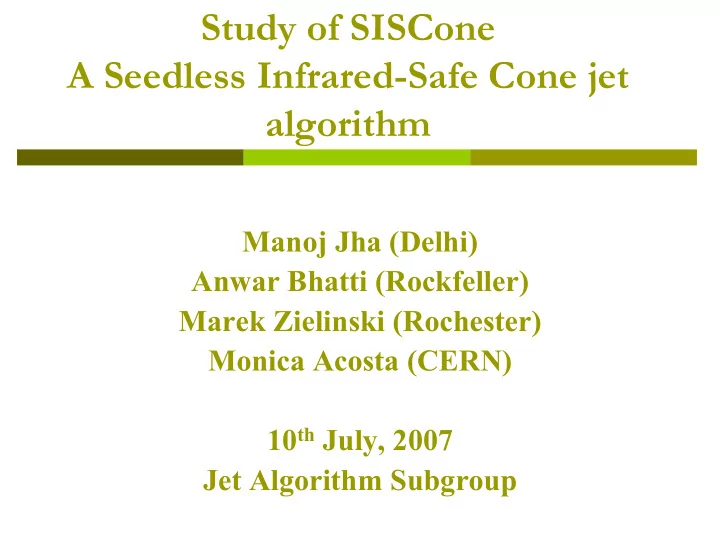

Study of SISCone A Seedless Infrared-Safe Cone jet algorithm Manoj Jha (Delhi) Anwar Bhatti (Rockfeller) Marek Zielinski (Rochester) Monica Acosta (CERN) 10 th July, 2007 Jet Algorithm Subgroup
Outline � Cone jet algorithm � Infrared-Safety issues � Why is this mandatory ? � IR unasfety of the midpoint algorithm � SIScone: A pratical solution � Comparison Plots � Conclusion & Next Steps 2
Cone jet algorithms � Given: set of N particles with their 4-momentum � Goal: clustering those particles into jets � Idea: jets = cones around dominant energy flows for a cone of radius R in the ( η , φ ) plane, stable cones are such that center of the cone ≡ direction of the total momentum of its particles � Algorithm: Tevatron Run II � StepI: find ALL stable cones of radius R � StepII: run a split-merge procedure with overlap fraction f to deal with overlapping stable cones 3
Midpoint cone algorithm Usual seeded method to search stable cones: MP cone algorithm � For an initial seed � sum the momenta of all particles within the cone centered on the seed � use the direction of that momentum as new seed � repeat above steps until stable state cone reached � Sets of seeds: � All particles (above a p T thresholds) � Midpoints between stable cones found in 1. Problems: � the p T threshold s is collinear unsafe � seeded approach → stable cones missed → infrared unsafety 4
Infrared Safety: Why ? IR Safety: Stability upon emission of soft particles, is required for perturbative computation to make sense ! Cancellation of IR divergences between Real and virtual emissions of SOFT gluons. � If Jet clustering is different in both cases, THEN the cancellation is not done and the result is not consistent with pQCD � Stable cones must not change upon addition of soft particles 5
SISCone: seedless solution � Naive approach: check stability of each subset of particle. Complexity is Ο (N2 N ) i.e. definitely unrealistic (10 17 years for N = 100) Idea: all enclosures are defined by pair of points Tricks: Traversal order to avoid recomputation of the cone content Complexity: � SISCone is Ο (Nn ln n) ( with n ~ N the number pf points in a circle of Radius R � Midpoint standard implementation is Ο (N 2 n) 6 � For more information: see 0704.0292[hep-ph]
Data Samples � CMSSW_1_5_0 pre6 RelVal Z’ → dijets � Considered Generated and Calorimetry jets only � Parameters for SISCone jets SISConeJetParameters = { double coneOverlapThreshold = 0.75 int32 maxPasses = 0 double protojetPtMin = 0. double cone radius = 0.5 } � Parameters MidPoint jets double seedThreshold = 1.0 MidPointConeJetParameters = { double coneAreaFraction = 1.0 int32 maxPairSize = 2 int32 maxIterations = 100 double overlapThreshold = .75 double coneRadius = 0.5 double inputEtMin = 0.5 double inputEMin = 0. } � No. of events = 1000 7
8 Comparison Plots
9 p T & η of Leading Jets
φ , No. of Constituents & Area of Towers Contributing for Leading Jets � Good agreement between jets from midpoint and SISCone algorithm. 10
Inclusive Jets p T Spectrum Generated Jets Calorimetry Jets 11
Difference in No. of Jets Generated Jets Calorimetry Jets � Midpoint algorithm produces ~ 5% more jets than jets from SISCone. 12
Inclusive Jets η Spectrum Generated Jets Calorimetry Jets 13
Diff. in No. of Jets in η Generated Jets Calorimetry Jets � Midpoint algorithm produces ~ 5% more jets than jets from SISCone. 14
15 Σ p T of all jets for p T > 10 GeV
Dijet Invariant Mass Generated Jets Calorimetry Jets � Difference in dijet invariant mass for gen and calo case is due to 16 non linear response of calorimeter .
Conclusions & Next Steps � Good agreement between jets from midpoint and SISCone algorithm � Midpoint algorithm produces ~5% more jets than SISCone � Next Steps: � Study the effect of dark energy towers on these algorithms � Study of pileup effect on these algorithms � Samples will be generated in different pT hat bins � Samples will be generated in different pT hat bins with pileup � Study hadronic top with and without pileup 17
Recommend
More recommend